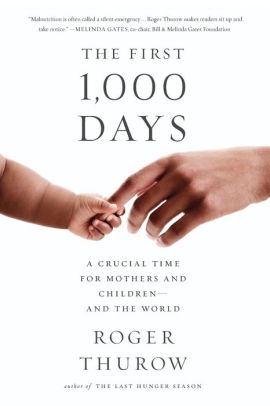The First 1,000 Days
Over winter break, I read a book called The First 1,000 Days by Roger Thurow. It’s a powerful story of mothers with young children in four different countries, and the international movement to support their health in the first 1,000 days of a child’s life. This was an eye-opening read for me.
 |
| Image credit: Barnes & Noble |
In The First 1,000 Days, Thurow presents the stories of moms in India, Guatemala, Uganda, and the United States from pregnancy to the second birthdays of their kids in 2015. They all do their best to provide for their children, but it’s not just a straightforward “food shortage” holding them back. There is inequality based on class and gender, poor sanitation and disease, social pressures, and government promises that fall short.
This is why today, 22% of the world’s children under five years old are stunted or chronically malnourished. This limits individuals, families, and entire countries.
 |
| Proper nutrition in the first 1,000 days can change a child's life image credit: UNICEF |
One factor is that global nutrition rarely gets the attention and funding it needs. Why? Hunger is nothing new, and we can all agree that it’s bad. The problem is, nutrition is complicated. You can’t just send grain overseas-- that doesn’t fix the problem. Sustainable change requires not just more food, but better food with the essential nutrients. We also need a strategy that focuses on the first thousand days, an approach to boosting health infrastructure, and you see where I’m going with this… it’s a lot.
| A baby at a UNICEF-supported nutrition center in the DRC image credit: UNICEF |
But Thurow’s book also highlights successful programs led by dedicated people. Global targets, including to reduce the rate of stunted children by 40% by 2025, are achievable if we step up our commitment. World leaders must realize what moms and health workers on the ground already know: nutrition is a health issue, a justice issue, and a security issue.
| Nutrition directly relates to goals #1, 2, 3, 5, 8, and 16 of the United Nations. Maybe more? image credit: National Geographic |
| RESULTS is writing letters to Congress about global nutrition |
It's already time for Congress to start working on the 2021 budget, and $200 million is recommended for Nutrition programs in Global Health in order to accelerate progress. That's actually only a tiny fraction (way less than a percent) of the money Congress spends every year, and it's well worth the investment. We can do our part by calling/writing to our Senators and Representatives, urging them to support the $200 million needed for global nutrition.
 |
| image credit: Power of Nutrition |
Additional dollars in funding help families like the ones in The First 1,000 Days. If you’re interested in learning more, I encourage you to read Thurow’s book or check out UNICEF’s page for nutrition on their website.


Comments
Post a Comment